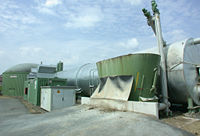
Photo from wikipedia
Microalgae is constituted by different compounds, interesting for the production of a wide range of end-products by using different technologies. Many potential possibilities have been developed under the context of… Click to show full abstract
Microalgae is constituted by different compounds, interesting for the production of a wide range of end-products by using different technologies. Many potential possibilities have been developed under the context of a biorefinery. The aim of this work is to evaluate the environmental performance of biogas production from Spirulina (Arthrospira maxima) through LCA using experimental and simulation results. For this purpose, kinetic models for batch cultivation and anaerobic digestion (AD) were determined from experimental data. Thus, Monod kinetic model and a first order model describe well microalgal biomass growth and AD, respectively. This model was used to simulate growth of Spirulina in a continuous system by using SuperPro Designer 9.5. Calculated results were compared to continuous experimental ones, obtaining good agreement in all cases. On the other hand, the whole process (cultivation, dewatering and AD of Spirulina biomass) was also simulated and the obtained results (material and energy balances) were used to construct LCA inventory data. Thereafter, environmental impacts were quantified through CML-2001 methodology using software Gabi 6.0. LCA results show that abiotic depletion of fossil resources (ADFR) category presents the highest impact, being biomass cultivation the most important contributor (about 56%). This result is directly related to the high energy consumption required for nutrient production, which also leads to increase remarkably the global warming potential (GWP) category. Main conclusion of the work is that the total/partial substitution of mineral fertilizers as nutrient source is the key to improve the environmental performance of the studied process. In this sense, a potential alternative could be the use of nutrients from wastewater or other wastes.
Journal Title: Renewable Energy
Year Published: 2018
Link to full text (if available)
Share on Social Media: Sign Up to like & get
recommendations!